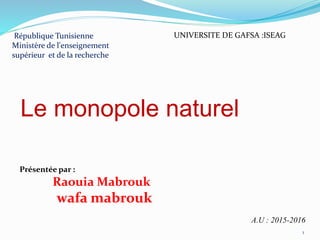
Le-monopole-naturel1111.pptx
- 1. République Tunisienne Ministère de l'enseignement supérieur et de la recherche Présentée par : Raouia Mabrouk wafa mabrouk UNIVERSITE DE GAFSA :ISEAG A.U : 2015-2016 1 Le monopole naturel
- 2. 2
- 3. 3 DÉFINITIONS Des exemples . Les politiques publiques envers le monopole naturel . CONCLUSION INTRODUCTION
- 4. Introduction Une entreprise est en situation de monopole si elle est la seule à offrir un bien particulier sur son marché, l’exemple le plus simple est celui d’EDF en France dans la distribution d’énergie et de gaz. Les modèles de concurrence monopoliste prennent généralement en compte le degré de substituabilité des biens, le coût de déplacement (la distance ) , et la durée du monopole. 4
- 5. 5 Définitions On désigne par le monopole naturel les secteurs d’activités qui engendrent des rendements d’échelle strictement croissant (ou le volume de production augmente avec le prix de vente) et par conséquent, par des coûts moyens strictement décroissant (c'est-à-dire que le coût moyen diminue avec le volume de production) et pour les quels un opérateur unique est nécessairement plus performante que les autres opérateurs.
- 6. Équilibre d’un monopole naturel . 6
- 7. Des exemples Les exemples de monopoles naturels les plus fréquents sont ceux de réseaux d’infrastructure, tel que les réseaux ferroviaires, les réseaux routiers et autoroutiers, les réseaux de distribution de gaz, d’eau, d’électricité, ports, aéroports… Dans ces situations, les pouvoirs publics justifient dans la plupart des cas leur intervention, sous plusieurs formes : exploitation publique, nationalisation, contrôle de la gestion privée par des délégations de service public… 7
- 8. Les politiques publiques envers les monopoles naturels i) La tarification au coût marginal Pour guider son action, le régulateur pourrait suivre un principe universel, bien résumé par Hotelling (1938). Théorème : (Hotelling, 1938) Le maximum du bien-être général nécessite que tous les biens soient vendus à leur coût marginal de production. Si l’on suit cette règle, le régulateur devrait donc imposer une tarification dite au coût marginal. 8
- 9. Autrement dit, connaissant le coût marginal du monopole naturel, il l’obligerait à vendre toute quantité offerte à un prix égal au coût de la dernière unité (infiniment petite) produite : p = Cm.Mais les choses ne sont pas si simples. L’adoption de cette règle fait supporter des pertes au monopole naturel, puisque son coût moyen est toujours plus grand que son coût marginal. Cette intervention doit donc s’accompagner du versement d’une subvention, visant à compenser la perte du monopole. 9
- 10. ii) La tarification au coût moyen On dit que le régulateur impose une tarification au coût moyen lorsque, connaissant le coût moyen du monopole naturel, il l’oblige à vendre toute quantité offerte à un prix égal au coût moyen de toutes les unités produites : p = CM. 10
- 11. 11
- 12. Conclusion La plupart des auteurs de l'école autrichienne d'économie remettent en cause l'existence de monopoles naturels en économie. Pour Friedrich Hayek, il ne peut y avoir de monopole que parce qu'il y a règlementation c'est-à-dire intervention de l'État. Selon Thomas DiLorenzo , le monopole naturel est n’a pas d’historique, car il n'existe aucune preuve dans l'histoire de son existence. Tous les monopoles qui ont pu perdurer jusqu'à aujourd'hui (télévision, téléphone, chemin de fer…) sont ceux qui ont bénéficié du soutien étatique . 12
- 15. 15